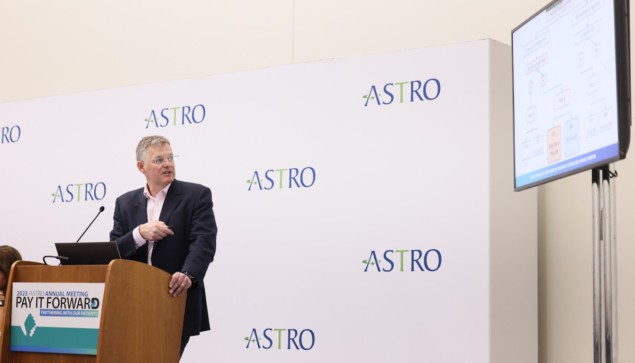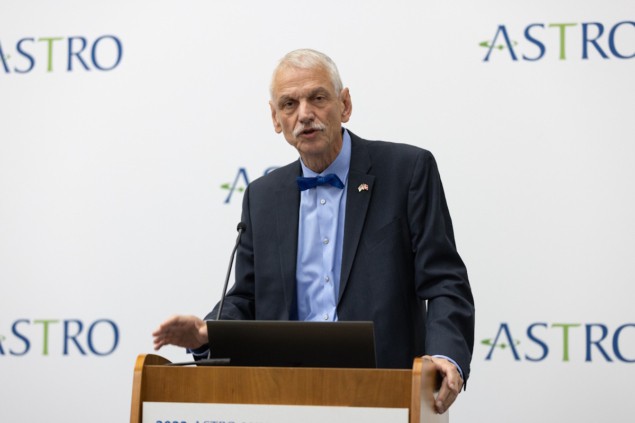
Radiation therapy, a mainstay treatment for many cancers, is usually delivered in numerous low-dose fractions over several weeks. But this drawn-out schedule can be problematic for patients. The ability to deliver an entire course of treatment in a shorter time, using a higher dose for each fraction, could have numerous benefits: reducing patients’ travel time and costs, minimizing their time off work, and enabling hospitals to treat more patients in less time.
In low- and middle-income countries (LMICs), where radiotherapy resources can be scarce and patients may live far away from their nearest treatment centre, an accelerated treatment regime could have even greater impact. At the ASTRO Annual Meeting, several studies demonstrated that it is feasible to deliver shorter courses of radiation therapy, without impacting tumour control or increasing adverse effects.
The HYPNO trial
Søren Bentzen from the University of Maryland School of Medicine shared the findings of the IAEA-sponsored HYPNO trial, a large international study comparing hypofractionated versus normo-fractionated radiation therapy for locally advanced squamous cell head-and-neck cancers.
Bentzen explained that each year there are 10 million deaths worldwide due to cancer and 70% of these occur in LMICs. And while head-and-neck cancers are relatively infrequent worldwide, they affect those in LMICs disproportionately. For example, an estimated 84% of deaths from head-and-neck cancer occur in LMICs, due in part to the link between head-and-neck cancers (other than those caused by the human papillomavirus) and use of tobacco and alcohol.

Standard treatment for such patients typically involves up to seven weeks of radiation therapy. This can be particularly challenging as the limited number of radiation therapy facilities in LMICs means that many patients have to travel great distances for treatment and remain away from home for long periods of time.
Following on from their mathematical modelling of clinical trial data, which suggested that fewer but higher doses of radiation could deliver outcomes similar to current radiotherapy regimes, Bentzen and colleagues tested this hypothesis in 792 patients with locally advanced head-and-neck cancer, mostly related to tobacco use. The patients, from 12 health centres in 10 LMICs, received either 33 fractions over 5.5 weeks (66 Gy total dose) or 20 fractions in 4 weeks (55 Gy total dose); most also received cisplatin chemotherapy.
After three years, patients who received the accelerated treatment had approximately the same level of local tumour control and late adverse events as those who received the longer conventional treatment. Overall survival and progression-free survival rates also agreed to within a couple of percent between the two groups.
The researchers note that this result is “potentially practice changing” and that treating in 20 fractions instead of 33 is both resource-sparing and more convenient for patients. “This is a trial that directly informs how you can effectively deliver radiation therapy to patients in a resource-scarce environment,” said Bentzen in a press statement.
The PACE B trial
The PACE (Prostate Advances in Comparative Evidence) study is a series of trials aiming to optimize treatment for men with prostate cancer. At the ASTRO meeting, Nicholas van As from The Royal Marsden NHS Foundation Trust and the Institute of Cancer Research shared the five-year outcomes from PACE B – a phase III trial comparing stereotactic body radiotherapy (SBRT) with conventionally fractionated radiotherapy for treating localized prostate cancer.
Patients receiving radiotherapy for intermediate-risk prostate cancer typically receive treatment in 20 (and up to 40) daily fractions. SBRT uses advanced imaging and treatment planning techniques to deliver radiation with extreme accuracy, minimizing damage to surrounding healthy tissue. It uses fewer, higher doses of radiation typically delivered in five or fewer outpatient sessions.
PACE B included 874 men with localized prostate cancer (10% low-risk and 90% intermediate-risk) who were not considering surgery. The patients, from 38 centres across the UK and Canada, were randomized to receive either SBRT (36.25 Gy in five fractions over one to two weeks) or conventional radiotherapy (78 Gy in 39 fractions over 7.5 weeks, or 62 Gy in 20 fractions over four weeks) to the planning target volume.
The researchers assessed the rate of biochemical clinical failure in the two groups. Results showed that five years after treatment, people treated with SBRT had a disease control rate of 95.8%, compared with 94.6% for conventional radiotherapy. “This was significantly better than we expected,” said van As in a news briefing. “We can say, with confidence that SBRT is non-inferior to conventional fractionation.”
Importantly, side effects were similar and low in both treatment arms. “I think it’s now imperative that our surgeons discuss these data with patients before they perform prostatectomies,” van As concluded. “We can also say now with a high level of confidence that SBRT can be considered the new standard-of-care for low- and favourable intermediate-risk prostate cancer.”
The FABREC study
Around 40% of people with breast cancer undergo mastectomies, with more than half having breast reconstruction immediately after. To minimize risk of recurrence, roughly one-third of these patients also receive radiotherapy, which is generally delivered over a period of five or six weeks. However, this post-mastectomy radiation greatly increases the risk of reconstruction complications such as infection and unwanted changes to cosmetic results.

Rinaa Punglia from the Dana-Farber Brigham Cancer Center described the findings of the FABREC study, the first to compare shorter versus longer courses of radiation specifically in people who underwent breast reconstruction immediately following mastectomy. Punglia explained that hypofractionation has already been widely adopted after breast-conserving surgery, where it is shown to produce equivalent oncologic outcomes, and improve quality-of-life and cosmetic results.
FABREC included 400 participants with stage 0 to 3 breast cancer who had mastectomy immediately followed by reconstructive surgery using a tissue expander or implant. The trial focused on patient-reported outcomes, particularly in terms of physical wellbeing, following hypofractionated or conventional radiosurgery.
Patients randomly received either 25 radiation fractions across five weeks (50 Gy total dose) or 16 fractions over roughly three weeks (42.56 Gy total dose), with a median time from surgery to the start of radiation of 2.6 months. In the conventionally treated group, 7.7% of patients had treatment breaks (missed days of therapy) that can lead to worse outcomes; this was reduced to just 2.7% with the use of hypofractionation.
Six months after treatment, patients in both groups reported similar levels of physical wellbeing. Younger patients (aged 45 or less), however, reported higher physical wellbeing scores and were less bothered by side effects after hypofractionated radiation. There were no differences in the rates of recurrence or toxicity outcomes between the two groups.

Shorter courses of radiation therapy prove safe and effective
The shorter treatment course also significantly reduced the burden on patients’ time and finances. Among those who took unpaid time off from work for treatment, patients in the hypofractionated group required 73.7 h of unpaid leave, while those receiving conventional fractionation required 125.8 h.
“Our trial results suggest that hypofractionation can safely be used in this setting without compromising efficacy or increasing side effects,” said Punglia in a press statement. “Reducing the requirement to three weeks of radiation therapy would be a significant improvement in the quality of our patients’ lives.”
- SEO Powered Content & PR Distribution. Get Amplified Today.
- PlatoData.Network Vertical Generative Ai. Empower Yourself. Access Here.
- PlatoAiStream. Web3 Intelligence. Knowledge Amplified. Access Here.
- PlatoESG. Carbon, CleanTech, Energy, Environment, Solar, Waste Management. Access Here.
- PlatoHealth. Biotech and Clinical Trials Intelligence. Access Here.
- Source: https://physicsworld.com/a/hypofractionated-radiation-therapy-faster-simpler-and-equally-effective/



